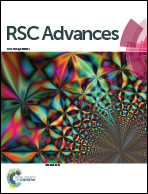A detailed study on the thermal, photo-physical and electrochemical properties and OFET applications of D–π–A–π–D structured unsymmetrical diketopyrrolopyrrole materials†
Abstract
A series of seven unsymmetrical diketopyrrolopyrrole (DPP) derivatives with donor–pi–acceptor–pi–donor (D–π–A–π–D) architecture have been designed, synthesized and well characterised. The effect of the electron donating capacity and extent of electronic conjugation of the end-capping units on the thermal, photo-physical and electrochemical properties of the synthesized materials was thoroughly investigated using various experimental techniques and theoretical calculations. Organic field-effect transistors (OFETs) were fabricated using these materials to obtain their hole/electron transporting characteristics. All these materials showed moderate to good hole transporting ability, and the OFET fabricated using the DPP-derivative with benzofuran and pyrene end groups exhibited a hole mobility of 6.7 × 10−4 cm2 V−1 s−1 with VT of −9 V. The observed photo-physical, electrochemical, thermal, and charge carrier properties of the synthesized DPP-derivatives indicated their applicability in various areas like organic photovoltaics, disposable electronics and biomedical devices.


 Please wait while we load your content...
Please wait while we load your content...